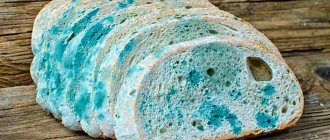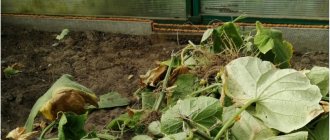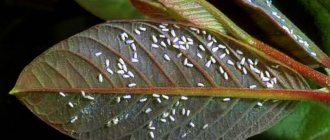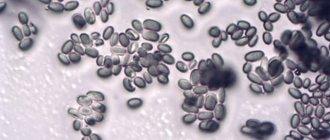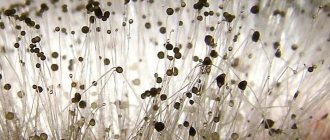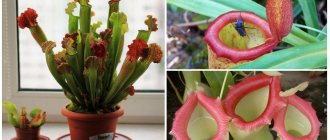White mold that appears on the ground in flower pots occurs due to improper care or the influence of negative external factors. Plaque usually begins to spread where the soil and the pot touch. It can be white or brown in color and has a high rate of spread.
There are always a lot of spores in the air. Under favorable environmental conditions, colonies of fungi are formed from them, which begin to multiply rapidly.
Types of mold
When faced with a problem such as mold in a flower pot, how to get rid of it depends on its type and the reasons for its occurrence.
Black mold
Black mold occurs due to high humidity. It can have different shades.
When this type of mold appears, you should immediately begin the process of getting rid of it, since it is the most dangerous for humans . Interaction with it can lead to an allergic reaction and breathing problems.
White types of fungus
White mold often appears in the soil, on trees and plants. The most common species, which mainly appears in flower pots.
In appearance, this fungus is similar to salt stains. They differ in structure. Salt deposits are microcrystalline formations that do not lose their shape. Mold can easily be rubbed in your hands.
Efflorescence
If a coating in the form of white, grayish or green spots is noticed on the soil, then this may be efflorescence - the result of chemical reactions and has nothing to do with mold. It negatively affects not only the outer part of the soil, but also penetrates into the inner layers.
Why is mold dangerous for plants?
The fungus that forms mold lives everywhere: in dark, damp basements and in bright, comfortable apartments. Its spores fly everywhere and, having found suitable conditions, begin to germinate. They are especially comfortable in flower pots, because it is damp and warm there.
Most often, white mold grows in them (mukor fungus), which also prefers organic debris, hay and food products. In people and animals with weakened immune systems, it can cause a serious infectious disease - mucormycosis.
Mold also causes significant harm to the plant in whose pot it has settled. A dense crust forms on the soil, which disrupts normal air exchange. The quality of the soil deteriorates due to changes in soil acidity and its mineral composition. Stems and leaves, not receiving the necessary nutrition, wither and dry, and the roots rot due to excessive moisture. If emergency measures are not taken, the plant will die.
Mold control methods
If mold appears in the ground and smells rotten, then it is necessary to adjust the plant’s watering schedule. It is recommended to reduce the frequency of watering and reduce the volume of liquid . Some plants just need moist soil. Otherwise, the roots may begin to rot, leading to fungal infections.
With abundant but infrequent watering, it is necessary to systematically loosen the soil. Moreover, deep layers must be affected. But you should be careful, as you can damage the root system .
How to get rid of mold in flower pots without harming the plant:
- If fungus is detected, it is necessary to remove the outer layer of soil from the flower pot . If this is not done, the infectious fungus will begin to spread to the inner layers, which will lead to rotting and death of the flower.
- Next, you need to moisten the lower layers of soil . To do this, pour a glass of water with citric acid diluted in it into the pot. The acidic environment prevents the fungus from multiplying, which has a beneficial effect on the growth of the flower.
- The removed layer should be replaced with new soil . It is necessary to add bactericidal agents to it, which will also act as filter components for incoming moisture. It is recommended to use additives such as crushed sphagnum moss and charcoal pieces.
- Next, the ground is watered with a special composition of foundation : 2 grams of the product must be diluted in 1 liter of water. If the infection spreads to the plant itself, it should also be treated with a solution.
In order for soil cultivation to have an effective result, it is periodically necessary to loosen its top layer. This will lead to an even distribution of moisture and prevent stagnation.
If the soil in the pot is covered with white mold, then it is necessary to water the plant with a solution of water and citric acid at least twice a month. For 1 glass of liquid, take 0.5 teaspoon of acid.
Video: Mold in a flower pot, how to get rid of white deposits on the ground.
Transplanting a plant
If mold appears in a flower pot, how to get rid of it quickly and effectively? An effective way to eliminate a fungal infection is to transplant the plant into a new pot and completely replace the soil. The soil should be selected taking into account all the rules for planting. For certain plants, it is necessary to find out the optimal humidity in advance.
Soil disinfection
To get rid of infection and the smell of mold, you can disinfect the soil according to the instructions:
- Separate the contaminated soil from the roots of the plant.
- Remove the soil from the flower pot and transfer it to another container.
- Put the water to boil.
- Pour boiling water over the soil.
- Place the soil on a baking sheet and bake in the oven.
- Wait until the substrate cools down.
- Treat the pot with a special disinfectant. You can also fire the pots with an open fire.
- Return the soil to the pot and plant the flower.
Purchased funds
You can get rid of mold using chemicals. They can be purchased at flower shops.
But when choosing this method, you should consider:
- type of soil;
- plant characteristics;
- degree of spread of the fungus;
- what fertilizers were used to till the soil.
Using the wrong product can have the opposite effect . And sometimes it is impossible to use chemical reagents to eliminate moldy stains.
Preference should be given to organic preparations that affect the soil and make it unfavorable for the development of fungus.
Mold Remedies
Antibacterial agents and antiseptics help a lot against mold. The simplest and most accessible, and at the same time reliable folk remedies are potassium permanganate and soda.
These substances are aggressive towards mold fungi and completely destroy the microenvironment suitable for the growth of fungi. The problem is that biologically active agents can also harm plants.
A weak pale pink solution of potassium permanganate should be poured onto fresh soil for flowers to prevent the appearance of mold and rot. Be careful and settle or strain the solution so that grains of manganese do not damage the delicate roots of the plant.
For plants that tolerate high soil acidity - begonias, roses, tradescantia - you can use lemon juice as a spray.
The best antibacterial agents:
- furatsilin solution at the rate of 1 tablet per 2 liters of water;
- weak pink solution of potassium permanganate;
- foundation solution;
- hydrogen peroxide solution.
If there is nowhere to get new soil to replace the contaminated one, it is recommended to calcinate the soil. The plant is dug up and temporarily placed in an antibacterial solution.
The earth is laid out on a steel sheet and calcined over a fire, and then steamed with hot steam. The procedure is long and labor-intensive. It's easier to buy new primer.
Danger to plants
Why it is necessary to get rid of mold and not allow it to spread:
- The plant begins to get sick, as mold prevents nutrients from reaching the stems, leaves and flowers.
- The root system does not receive enough oxygen.
- Fungus in the soil can cause various flower diseases.
- Due to increased humidity, the roots of the plant may begin to rot.
If you do not fight the mold fungus, the plant will rot and die.
Danger of molds
The development of mold fungi leads to the formation of soil compactions, loss of air exchange, and processing of plant roots into food for mycelium. Plants can resist for a long time, they get sick, their leaves turn yellow, but the end is always the same. In the confrontation, mold wins and the infected plant dies.
You can try to save the plant by cauterizing the affected area with potassium permanganate or pouring antiseptics into the soil, but the likelihood of victory in most cases is low. It is necessary to change the soil, change the pot, cut off the affected part of the plant and re-root.
Not all types of mold are harmless to humans. Particles of mycelium, fungal spores are a powerful allergen that can seriously affect health, weaken the immune system, provoke a chronic runny nose, bronchitis, and increase the tendency to colds.
Dandruff on the head and skin of a person is also caused by mold fungi. If mold is not combated with the most active and irreconcilable methods, mycoses are inevitable.
With reduced immunity, mold fungi can develop activity inside the body of humans and animals. Mold also successfully affects aquarium fish, reptiles and amphibians.
Causes of the appearance and spread of fungus
There may be several reasons why fungus forms on the soil surface:
- Using the wrong regime for watering the plant, which leads to stagnation of liquid and increased soil moisture.
- Low temperature and high humidity of the room in which the flower is located.
- Application for cold water irrigation.
- Poorly functioning drainage system. If the holes do not match the size of the pot, they become clogged. Which leads to stagnation of water in the soil. After 2-4 days, the first traces of mold may appear.
- Poor quality soil.
Excess moisture and infrequent ventilation contribute to the rapid spread of mold . The most common times for infection to appear are autumn and spring. During these periods of time, cold air accumulates in the room, which leads to the slow evaporation of moisture from the surface of the soil. As a result, fluid stagnation occurs and fungal spores spread.
The cause of fungus can be increased dampness in the house. This may be due to poor communication systems or the presence of a basement.
Harm from mold
Mold crust looks unsightly, but the harm of pathogenic fungi is not limited to this. There are types of mold that cause allergies in people and even provoke the development of cancer.
Due to the fungus covering the soil surface, the plant does not receive enough oxygen and nutrients. A mycelium penetrating the soil will sooner or later cause root rot.
Therefore, there is no point in finding out exactly what type of fungus has infected the soil and how harmful it is. If mold appears in the pot, it must be destroyed.
Preventative measures to prevent the appearance of mold
What to do to prevent fungus in flower pots:
- systematically loosen the soil - these actions will provide the lower layers with oxygen and increase the degree of ventilation of the substrate;
- make a drainage system in accordance with the standards;
- keep plants in flower pots that have holes in the bottom in the required quantity and appropriate size;
- Feed the soil with activated carbon or wood ash - this will help improve the ventilation process and protect against infections.
, the soil should be treated with potassium permanganate for prevention . The procedure must be carried out once a month. But you cannot use a solution that is too concentrated , as this can lead to the death of the plant.
Expert opinion
Vasily Dmitrievich
Local hobby gardener and article editor for Agroved.org.
Another folk remedy is garlic. It prevents the development of fungus. The garlic is cut into several pieces and placed next to the stem of the plant while watering. After the soil dries, it is removed.
For prevention, it is recommended to use garlic once a week. To treat affected soil, the frequency of its use is 10-15 times a month.
Causes of mold in flower pots
Excess moisture is the main reason why mold grows in flower pots. This happens mainly due to mistakes in caring for indoor plants.
So, a pot may have poor drainage, causing water to stagnate in it, or a small drainage hole that often becomes clogged.
Excessive and frequent watering also contributes to the appearance of mold. However, the quality of water plays an important role in this, especially if you water it with liquid from the tap.
Mold usually grows where there is high humidity. In an apartment this most often happens when there is no heating and it is cool outside. Plants then consume less water, and due to low temperatures, moisture evaporates from the soil slowly. As it accumulates, it creates optimal conditions for the development of a fungal infection.
Mold can also get into the pot from poor-quality soil. The fungus also develops well on clay and heavy soils.
Tips for preventing soil contamination by fungus
If you regularly take preventive measures, you can avoid problems such as mold and rotten smell. The process of getting rid of fungus is much more difficult and takes longer. By creating favorable conditions for plant growth and acquiring high-quality soil, the likelihood of the soil becoming infected with a fungus is minimal. Therefore, it is necessary to ensure systematic ventilation, sufficient lighting and an optimal level of air humidity .
Indoor plants should not be in a draft. Special shelves or stands for flowers are best suited.
If you have indoor plants in your home, it is not advisable to use a humidifier. Since increased humidity levels create favorable conditions for the development of infection.
In order not to think about the question of how to remove mold from the ground, you should follow some tips :
- buy soil at specialized retail outlets;
- before purchasing, you need to read the composition of the soil;
- if the substrate is too heavy, then it is not recommended to purchase it, as the fungus will spread even faster in it;
- Before planting a plant, it is advisable to treat the soil with potassium permanganate; it will disinfect it and reduce the likelihood of fungus appearing.
Before breeding certain types of plants, it is necessary to familiarize yourself with the characteristics of their growth and follow the recommendations for watering them.
Transplanting a plant
The most effective way to combat infection is to replant the crop. This procedure helps not only get rid of mold, but also eliminate other problems, as well as provide the plant with nutrients, because it has managed to pull out all the minerals from the old soil.
See also Fungus and mold of strawberries
The substrate for transplantation must be selected taking into account all the rules and requirements for a particular flower. It is important to ensure good drainage. To do this, charcoal, broken polystyrene foam or small pebbles are placed at the very bottom of the pots.
After removing the contaminated soil composition, it is recommended to wash and disinfect the pot. The permissible moisture level should also be clarified in advance for a specific crop and not exceed it.
Prevention of fungus
It is not difficult to prevent all types of mold from appearing in a flower pot. Regular care of the flower, compliance with temperature indicators and watering standards will bear fruit.
Six simple rules will reduce the risk of developing mold fungi:
- moderate watering with lukewarm water;
- arrangement of drainage at the bottom of the flowerpot;
- room temperature optimal for plant development;
- mixing potting soil with pieces of charcoal. A good option is crushed activated carbon for soil disinfection;
- watering to prevent rot with a solution of citric acid;
- regular loosening of the soil.
Simple preventive measures will not leave a chance for mold fungi to develop in a flower pot. Attention to indoor plants, maintaining temperature conditions, optimal humidity, and enriching the soil with oxygen will maintain the high quality of the soil. With careful care, it is not difficult to deal with mold early on.
What to do if there is mold in pots with house plants? How to deal with colonies of fungal formations? Useful recommendations for flower growers in the following video:
